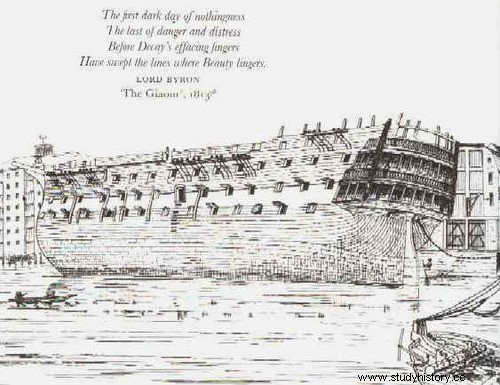Reckless
The 107 ships of the line of the Téméraire class were built by France between 1782 and 1813; they constitute the first series of ships of the line built according to identical plans, their elements being thus interchangeable between two ships of the series.

History
During the first half of the 18th century, the French navy gradually developed a new type of second-rate line ship, carrying seventy-four guns, the first representative of which was the Bourbon. A large number of copies were built, varying in size and somewhat in the arrangement of the armament. The one initially made up of 26 pieces of 36 pounds, 28 of 18, 16 of 8 and 4 of 4, was fixed from the Terrible of 1739, at 28 of 36, 30 of 18 and 16 of 8.
A certain number of specimens were captured, in particular by Royal Navy, which after having used them, undertook to build similar models. Eventually, this type of ship quickly became the backbone of all European combat fleets.
At the end of the Seven Years' War, its fleet decimated, the Kingdom of France launched a new naval construction program. Under the leadership of the knight Jean-Charles de Borda, assisted by the naval engineer Jacques-Noël Sané, the types of buildings are standardized, thanks to the establishment of plans at 1/48 scale, and the parts, in especially the masts, are standardized. The plans for the 74-gun ship are drawn up for the construction of the ship Téméraire, which thus becomes the leader of a long series.
Description
The hull is 172 French feet long, or 55.87 meters, and 44 feet and 6 inches wide, or 14.90 meters, and has a depth of 22 feet in the center, or 7.26 meters. The displacement is 2900 tons.
The sails are three-masted, square-rigged, with three tiers of sails, forward three jibs and a stretcher. Stays sails, as well as windscreens can be added under favorable conditions. The surface is 2485 m². The crew needed to man these ships is 562 officers and men.
The building is two-deck, that is to say that its artillery occupies two full decks. The lower deck, closest to the waterline, is lined with fourteen 36-pounder guns on each side. These pieces, 3.274 meters long, weigh 3520 kg, to which are added the 900 of its mounting, their service requires fifteen men, they are capable of sending a full ball of 17.62 kg to 3700 meters, approximately every eighth minutes. The bridge just above is armed with two rows of fifteen 18-pounders. These battery decks are 1.75 meters high and cover almost the entire length and width of the ship, except the extreme rear which is dedicated to officers' quarters. The rest of the armament is placed on the poop deck, it consists of sixteen 8-pounders. Thereafter, the progressive introduction of the carronades, is going some can to make evolve/move the provision of the armament. From 1788, four of them, of 36 pounds, were added to the poop deck. In 1808, their number was increased to ten for the loss of two 8-guns. After the imperial period, we went even further, rearming some of the still existing ships, according to two arrangements, one removed the fourteen pieces of eight still present , for the benefit of twelve additional carronades and two pieces of 12 pounds, the other even more radical, replaces the pieces of 18, carronades of 36 and removes the upper pieces. It should be noted, however, that all these artillery endowments are theoretical and maximum, and in practice, in times of war, due to the shortage of guns and gunners, the buildings were often less well armed.
Following criticism from Minister of the Navy Forfait, a series of ships was launched with slightly reduced dimensions, only 169 feet (53.5 m) long, 44 feet (14.50 m) wide and 21 feet and 3 inches deep. (7.2 m), the armament was the same as on their big brothers, with 4 then 10 carronades, but they proved to be much less good, the hull being overloaded.
